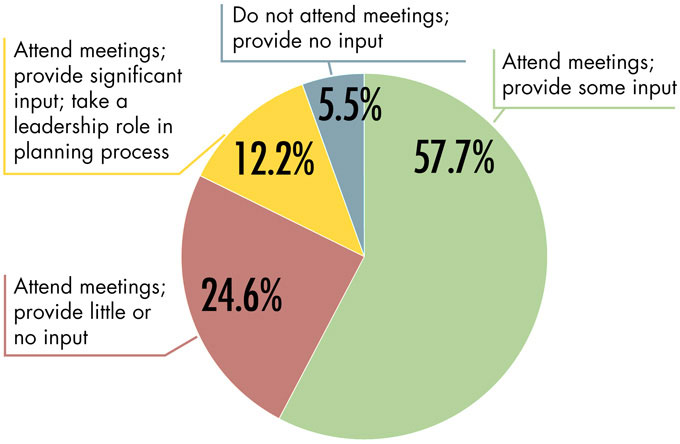What is student-centered transition planning?
Page 1: Student Involvement in the IEP Process
 In the United States, the Individuals with Disabilities Education Act (IDEA) governs the education of students with disabilities. The law guarantees that each student—from infancy through high school graduation or age 21—will have an individualized education program (IEP)—a document or strategic plan outlining the student’s annual learning goals and objectives, as well as the supports and services required to achieve those goals. A kind of roadmap laying out a course for students to follow, IEPs are developed by a multidisciplinary group, referred to as the IEP team. This team meets at least once a year to review the student’s progress.
In the United States, the Individuals with Disabilities Education Act (IDEA) governs the education of students with disabilities. The law guarantees that each student—from infancy through high school graduation or age 21—will have an individualized education program (IEP)—a document or strategic plan outlining the student’s annual learning goals and objectives, as well as the supports and services required to achieve those goals. A kind of roadmap laying out a course for students to follow, IEPs are developed by a multidisciplinary group, referred to as the IEP team. This team meets at least once a year to review the student’s progress.
Individuals with Disabilities Education Act (IDEA)
glossary
individualized education program (IEP)
glossary
At a minimum, an IEP team should include the student (when appropriate); a parent or guardian; a special educator; a general educator; a school or district representative knowledgeable about specially designed instruction, the general education curriculum, and resource availability (e.g., a school administrator); a related service provider (when necessary); someone who can interpret the instructional implications of evaluation results (e.g., a special education teacher, a school psychologist); and other individuals based on the needs of the student in question. By the time the student reaches the age of 16 (although in some states as early as age 14), the IEP team should also include a transition component to address life after high school in the areas of education, training and employment, and independent living. At this point, additional IEP team members with expertise in these areas (e.g., a vocational rehabilitation counselor, an independent living coordinator) should be added. Because transitions are so personally defined—with postsecondary goals developed around a student’s interests, needs, and strengths—it is considered best practice to include and involve the student in this process.
Despite this, students with disabilities are often only minimally involved in the annual IEP process. Though these students are considered to be members of the IEP team, too often the adults in charge of coordinating the meeting do not plan those meetings with the student’s participation in mind, outside of their mere attendance. Meetings are held, decisions made, and progress discussed, but the student rarely presents her perspectives, or is otherwise not prepared or encouraged to take an active part in this critical process of life-planning.
The graphic below illustrates the findings from a large-scale study of more than 11,000 students, aged 14–22. Although 94.5% of students attend their IEP meetings, only 12.2% offer significant input. Ideally, as students’ progress toward graduation and planning for their future, they should become more actively involved in the transition planning process and as advocates for their interests, needs, and preferences.
Student Involvement in IEP Meetings

This pie chart is divided into four slices representing the involvement of students in IEP meetings. The largest slice is green. It is labeled 57.7 % represents students who attend meetings and provide some input. Next is pink slice of the pie chart at 24.6%. It represents students who attend but provide little to no input. The next slice of the pie chart is yellow at 12.2%. This slice shows the students who attend their meeting, provide significant input, and take a leadership role in planning process. The smallest slice is blue at 5.5%, representing students who do not attend meetings and who therefore provide no input.
Activity
Think back to when you were a junior in high school, looking forward to graduating the following year. Imagine that your family and teachers are holding a meeting plan your future: selecting your senior-year classes, your summer job, which college you will attend, your future career. Now, think about the following questions:
- How would you have felt about these people planning your future without asking you what you wanted?
- Would their choices have aligned with your goals and objectives for your life?
- Why would it be important for you to be included in the conversations about your future?
- What important skills do you think you would gain from being an active participant in the conversations?
- What type of environment would have helped you feel comfortable in actively participating in such a meeting? What factors would have made you feel welcome and encouraged to engage with the other members of the IEP team?
To ensure that student voices are heard and that the transition components of the IEP represent what they envision for their future, it is important that the IEP team take steps to actively involve students with disabilities in the planning of their own futures. Although active participation will look different for every student, overall the goal is for students to take on as much ownership as possible. The skills necessary for them to do so fall along a continuum and range from something as simple as the student feeling comfortable introducing herself in an IEP team to more complex activities such as discussing and developing goals. On the following pages, this module will offer more details about these skills, as well as an in-depth look at the transition planning process.